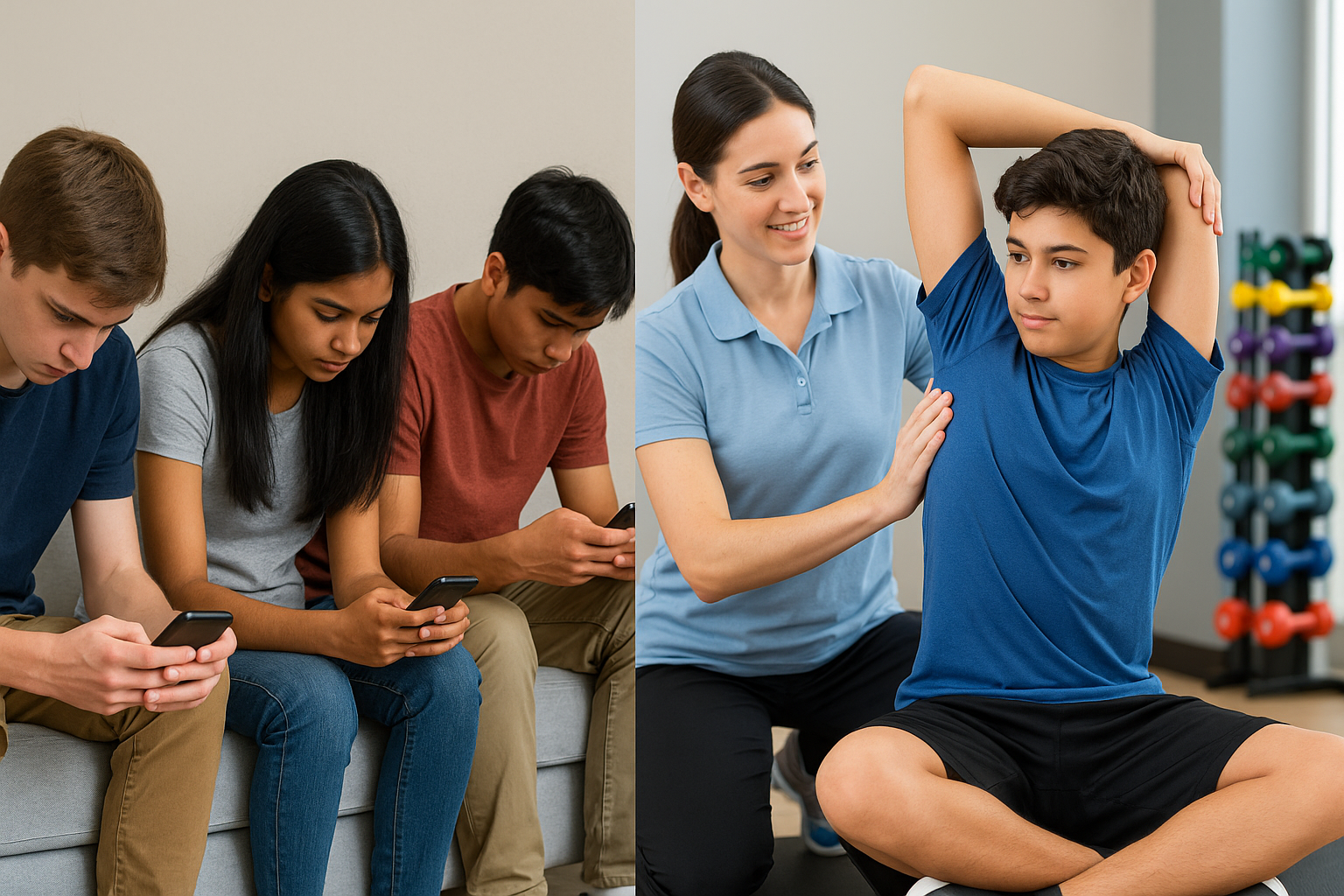The lifestyle of teenagers is changing rapidly in India’s cities, with screens replacing playgrounds and long hours of passive device use taking over from active movement. A new study by the All India Institute of Medical Sciences (AIIMS), Delhi, has put data behind what many parents already suspect: today’s “slouch-sit-scroll” routine is hurting the physical health of adolescents in measurable ways.
Conducted between October 2023 and 2025 in collaboration with the Indian Council of Medical Research (ICMR), the research followed 380 students aged 15–18 years from two Delhi schools. It examined posture, flexibility, and musculoskeletal health and introduced physiotherapy-based interventions to test possible solutions.
Rising Health Concerns in a Gadget-Heavy World
The AIIMS study highlights how the combination of extended screen time, sedentary routines, and loss of traditional movement patterns is taking a toll on young bodies. Instead of spending time in natural physical activity, many teenagers spend their day slouched over smartphones, laptops, and tablets. This change in daily habits is linked to a growing list of health concerns:
- Postural abnormalities such as forward head posture and rounded shoulders.
- Neck and shoulder pain from constantly looking down at screens.
- Lower back pain from prolonged sitting in static, unsupported positions.
- Muscle tightness, especially in hamstrings and the iliotibial (IT) band.
- Flat feet and weak arches, partly due to less barefoot activity.
- Loss of flexibility, as fewer children sit cross-legged or squat—positions that naturally stretch and strengthen the body.
For teenagers, these issues are particularly concerning because their bodies are still developing. Early musculoskeletal strain can have lifelong consequences if ignored.
Why Teenagers Are More Vulnerable Today
Experts point to several reasons why today’s teens are experiencing problems at a scale that earlier generations did not:
- Excessive device use: Long hours of scrolling, gaming, and online classes keep children in static positions.
- Reduced outdoor play: Traditional unstructured play and sports are increasingly replaced by digital entertainment.
- Cultural lifestyle shifts: Sitting on chairs instead of on the floor, wearing cushioned shoes instead of going barefoot, and a general decline in physical chores reduce natural movement.
- Lack of warm-up routines: Many students go straight into sports or physical activity without stretching, leading to injuries and stiffness.
This combination has created what doctors describe as a “generation at risk”—young people who may appear healthy on the outside but are already showing early signs of lifestyle-related musculoskeletal stress.
Physiotherapy as a Corrective Tool
The AIIMS study went beyond observation by introducing a 12-week physiotherapy program. Students were guided through exercises to correct posture, improve flexibility, and strengthen supporting muscles. The results were encouraging:
- Students showed improved mobility and strength.
- Pain and stiffness were reduced in many cases.
- Flexibility in hips, hamstrings, and shoulders improved with consistent practice.
These findings confirm that targeted interventions can reverse or mitigate damage caused by sedentary habits. However, physiotherapy works best as part of a broader lifestyle shift. Without changes in daily routines—like balancing screen use, encouraging regular physical activity, and teaching posture awareness—the benefits may be short-lived.
The Role of Parents in Preventing Long-Term Damage
Parents are at the frontline of this issue. Small adjustments at home can help counterbalance gadget-driven lifestyles:
- Setting healthy limits on screen use and ensuring digital breaks.
- Encouraging outdoor activities and sports that promote stamina, strength, and social skills.
- Promoting traditional sitting postures like cross-legged or squatting, which naturally enhance flexibility.
- Introducing family routines like evening walks, yoga sessions, or stretching.
- Creating ergonomic study spaces that support healthy posture.
By combining awareness with everyday practices, families can reduce the risks identified in the study and support healthier growth for their children.
Schools as Gatekeepers of Health and Learning
The study also calls attention to the role of educational institutions. Since students spend most of their day at school, interventions there can make a significant difference. Experts recommend:
- Incorporating posture awareness programs into health and physical education.
- Scheduling regular stretching and movement breaks during long study sessions.
- Appointing or collaborating with school physiotherapists and wellness experts.
- Designing timetables that give students adequate opportunities for outdoor sports and unstructured play.
- Teaching children about the long-term impact of sedentary habits through workshops and awareness campaigns.
If schools embrace these strategies, they can help counterbalance the pressures of digital education and ensure students grow up healthier.
Building Healthier Habits for the Next Generation
The most important lesson from the AIIMS study is that the problem is real but reversible. Teenagers may not notice the discomfort now, but their bodies are already showing stress signals. If ignored, these could translate into chronic pain, reduced mobility, and long-term health risks in adulthood.
The path forward lies in balance—balancing digital learning with outdoor play, balancing gadget use with active movement, and balancing modern lifestyles with traditional practices that promoted natural flexibility. Parents, schools, and policymakers all have a role in creating that balance.
By taking action now, Delhi’s teenagers—and millions of others across the country—can look forward to healthier, stronger, and more resilient futures.
FAQs
What is the AIIMS study on Delhi teens about?
The study by AIIMS, with ICMR support, examined how prolonged screen time and sedentary habits affect the posture, flexibility, and musculoskeletal health of teenagers aged 15–18.
How many students participated in the AIIMS study?
The research covered 380 students from two private schools in Delhi between 2023 and 2025.
What health issues were found in gadget-using teens?
The study found forward head posture, rounded shoulders, neck and back pain, tight hamstrings, IT band stiffness, flat feet, and reduced flexibility.
Why are today’s teens more at risk of posture problems?
Excessive screen time, less outdoor play, fewer barefoot activities, and skipping warm-ups before sports are key factors making teens more vulnerable.
Can physiotherapy help correct these issues?
Yes. A 12-week physiotherapy program in the study showed significant improvements in posture, flexibility, and muscle strength.
What can parents do to protect their children?
Parents can limit screen use, promote outdoor play, encourage posture-friendly sitting, ensure warm-ups before sports, and create ergonomic study spaces at home.
How can schools help address this problem?
Schools can integrate physical activity breaks, posture awareness programs, and physiotherapy or wellness sessions into their daily routines to reduce risks.
Are the health effects of slouching and scrolling permanent?
No. Experts say the problems are reversible if addressed early with physiotherapy, posture training, and lifestyle changes that balance screen time with active movement.

